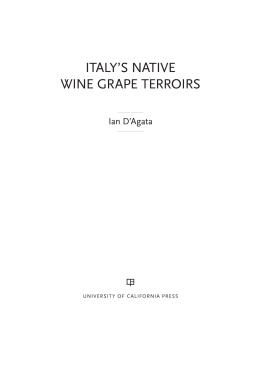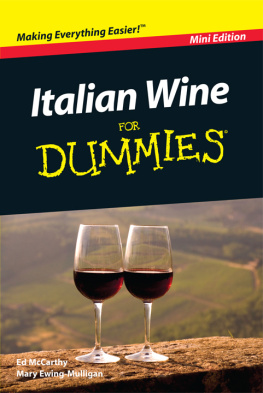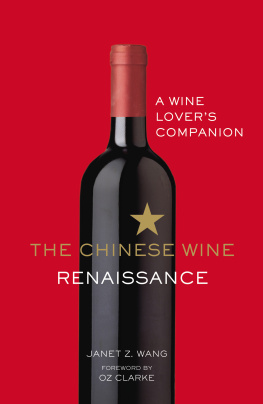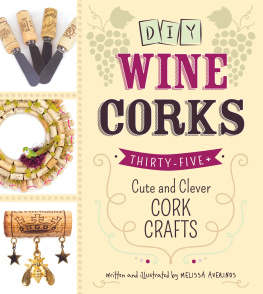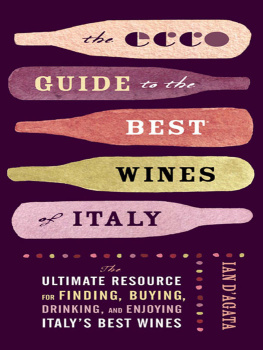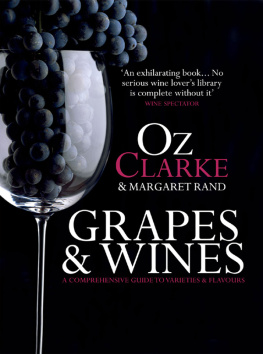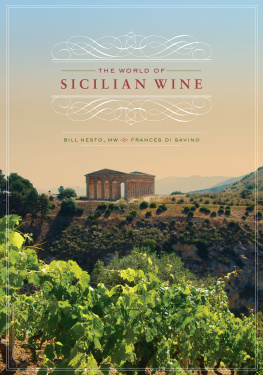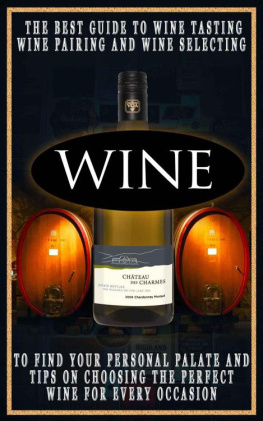The publisher and the University of California Press Foundation gratefully acknowledge the generous support of the Simpson Imprint in Humanities.
ITALYS NATIVE WINE GRAPE TERROIRS
Ian DAgata

UNIVERSITY OF CALIFORNIA PRESS
University of California Press, one of the most distinguished university presses in the United States, enriches lives around the world by advancing scholarship in the humanities, social sciences, and natural sciences. Its activities are supported by the UC Press Foundation and by philanthropic contributions from individuals and institutions. For more information, visit www.ucpress.edu.
University of California Press
Oakland, California
2019 by The Regents of the University of California
Library of Congress Cataloging-in-Publication Data
Names: DAgata, Ian, author.
Title: Italys native wine grape terroirs / Ian DAgata.
Description: Oakland, California : University of California Press, [2019] | Includes bibliographical references and index. | Description based on print version record and CIP data provided by publisher; resource not viewed.
Identifiers: LCCN 2018049276 (print) | LCCN 2018050702 (ebook) | ISBN 9780520964778 (ebook) | ISBN 9780520290754 (cloth : alk. paper)
Subjects: LCSH : TerroirItaly.
Classification: LCC SB 387.8. I 8 (ebook) | LCC SB 387.8. I 8 D 34 2019 (print) | DDC 634.80945dc23
LC record available at https://lccn.loc.gov/2018049276
Manufactured in the United States of America
28 27 26 25 24 23 22 21 20 19
10 9 8 7 6 5 4 3 2 1
CONTENTS
PREFACE
Universities are the ultimate learning institutions, and our student days have left us all with memories (scars?) of long nights poring over our textbooks and of exams hazardous to our fingernails. Not all of the immense amount of knowledge I was exposed to in medical school has remained embedded in my neuronal network: but what did stick I have been using routinely in my wine writing since. One important lesson was learning to pick the right lunch spot. Really, its a skill. One bright Sunday, I joined friends for lunch in the charming countryside of Frascati, near Rome, in a fojetta (the localyou might say nativeword for trattoria ). At precisely that moment in time somewhere on the other side of the world a butterfly must have fluttered its wings, and my life was steered in a completely different direction. The fojetta s food was hearty, and the house wine much better than others served in similar dining establishments. In fact, so much better that I could not resist asking the fojetta s owner, Alfonso, why this was so. He promptly pulled up a chair, joining us at the table (what can I say, Italy is a friendly place) to tell us all about his wine. My friends got into it, too (asking questions is just part of being a medical student, I guess ... ), and so it was that Alfonso doffed his apron, waved good-bye to his wife, telling her he was off to the vineyards with us, and left her standing there (open-jawed) to (wo)man the busy lunch hour. I am not sure what the poor lady thought of the whole affair, but I do know that for the rest of us it turned out to be one great afternoon. Standing in front of a rickety maze of gnarly old vines of a local Malvasia grape that apparently nobody else in the area owned vines of anymore, Alfonso proudly told us that those rare, forgotten grapes were the secret to his wines success. It didnt take a degree in ampelology to figure out what he was talking about: even to novices like us, those portly, speckled grapes glistening in the Roman afternoon sun were obviously different from all the other Malvasia grapes hanging around in vineyards surrounding Alfonsos small plot. But for whatever reason, he added, these grapes weave their magic only in this precise spot. Ive tried replanting them near my house, but the wine just isnt the same. I remember that those words got me thinking. I was still thinking about them the next day, in class and later still that evening, while having dinner with my wine-loving girlfriend. You might say I havent stopped thinking about them since. In fact, native grapes and the role of site specificity in wine have guided me, polestar-like, in a lifetimes journey devoted to wine.
As anyone who has read my earlier book Native Wine Grapes of Italy (DAgata 2014a) knows, I have always been fascinated by native grapes, their histories and characteristics; simply put, if you dont know the grape varieties or cultivars (cultivars are cultivated grape varieties, as opposed to wild ones), you dont know the wines. One aspect that has always intrigued me most is the terroir-related expression of grapes in wines. F. Scott Fitzgerald said it best: First you take a drink, then the drink takes a drink, then the drink takes you (Fitzgerald 2011); if in a different sense than the one he was getting at, much the same thing happens with wine knowledge. When people try a wine they like, natural human curiosity drives many to learn more about it; that wine inevitably brings them to try other wines made with the same grape variety or from the same country. In time, these same people might wish to understand why Arneis wines from Oregon taste so different from those made in Italy. Others might find themselves scratching their heads as to why a Barbaresco producers Asili wine offers obviously different nuances from that same producers Barbaresco Rabaj (even though they might be told the wines are similarly made). For many of us, figuring out why such differences surface and what causes them is a huge part of wines attraction. Of its magic, even.
With most writers, there is often a theme that is repeated throughout their work to varying degrees over time. And so it is with me. I have been fascinated by Italys native grapes and their wine terroirs for close to thirty years, speaking about these topics in wine courses then writing about them, first in Italian wine periodicals and later for Stephen Tanzers International Wine Cellar and as contributing editor of Decanter magazine; I now do the same as the senior editor of the website Vinous (www.vinous.com). Furthermore, native grapes and wines are my focus as the director of the Indigena festival held annually in Barolo, the Indigena World Tour, and 3iC (the Italian International Indigenous Center for Wine and Food Studies) wine and food school, also in Barolo. All my life, I have never ceased to be amazed by how native grapes and their wines express a distinctive signature of place, what in Italy is aptly termed the genius loci, or genius of place. Therefore, the book you hold in your hands is the logical, even inevitable, follow-up to Native Wine Grapes of Italy ( NWGI ); it is a summary of my adult-life-long search for the genius loci. A search for wines that are grounded in nature and that speak the voice of the land. Wines that explode in the glass with the colors and textures, the memories and souls, of specific places and people. Wines of intergenerational reach, so very different from many of todays liquid cultural relics with nothing to say. In NWGI, the quest was about learning in detail about Italys myriad wine grapeswhere they have come from, and what their wines are like. With Italys Native Wine Grape Terroirs, we see them through a different looking glass, no longer on their own but through their interaction with specific places and human beings. And though Italys Native Wine Grape Terroirs takes you down a totally different rabbit hole than NWGI, much like the latter book it is meant to be both an academic text and a quick reference guide to Italys most interesting wines and significant (best?) terroirs. I am aware that the subject matter of this book is at times deeply rooted in scientific facts and data, but my hope is that you will enjoy spending time in its company anyway. That is, if our goldfish-like eight-second attention span allows it (McSpadden 2015).

